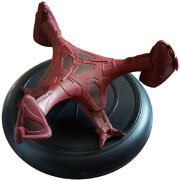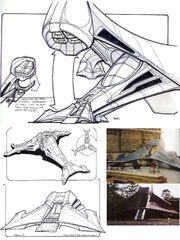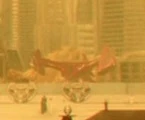(written from a Production point of view)

The T'Plana-Hath
While designing the T'Plana-Hath-type for Star Trek: First Contact, John Eaves, the chief designer, wanted something with a "spinning" element – referring to Probert's Trumbull–inspired "half gainer" –, after the Vulcan courier from Star Trek: The Motion Picture, so he designed the legs to fold into the thruster packs, and as the ship landed they would fold out, spinning on their way down.
The red hue eventually given to the otherwise unconventional design has been a co-influence on Doug Drexler's Suurok-class and thereby establishing the hull color as a signature feature of Vulcan starship classes.
Design[]

Eaves' design concepts
When asked to design a Vulcan spacecraft, Eaves was surprised that there were very little references, with only the long range shuttle and the Apollo-class to proceed from, leaving him more or less free to design whatever he felt like. "I was surprised that a Vulcan ship had never been shown before, but it freed me up to design something from scratch. I tried to think like a Vulcan, creating something that was both artistic and logical.", Eaves himself recalled (Cinefex, issue 69, p. 118) and,
"I decided to make the ship more artistic than aerodynamic, and to take its design essence from the sea; if you look down on the craft, you might feel you were looking at a starfish-with three limbs instead of five. Usually crafts-Human crafts, at least-are designed with an even number in mind, for balance. Well, this structure has balance, only with an odd number of pieces, and with curves instead of straight lines. The main body of the craft is triangular; from it extend three arms containing the engines and propulsion systems. Those "arms" serve a double purpose-as landing legs, The bottom of the engines are also triangular, and the bottom of the landing foot also has an open-faced triangle. When the legs deploy for landing, the fork that makes the thrust-ring drops down and makes the landing platform with the main hatch situated in the center of the foot. In turn, each leg of the vessel has a hatchway. Herman really liked it right away, so I sent it to Mr. Berman, who called and said, "This is exactly the ship I want." I continued to do the detail sketches; Peter Lauritson and David Takemura were heavily involved with the final designs, in order to ensure the CGI modelers could make look good on the big screen." (Star Trek: The Next Generation Sketchbook: The Movies, p. 220)
Study model[]

Eaves' T'Plana-Hath-type study model....

...and its commercial derivative by Legends in 3 Dimensions
While designing the "Vulcan Lander", the design became so intricate that Eaves painted himself into a corner and he had to build a study model, or as he put it, "I had trapped myself with this design: from a three-quarter or top view I could draw it just fine. But I found it almost impossible to figure out how it would look in other angles, because all the bizarre compound curves had minds of their own-making accuracy insanely frustrating to achieve when I tried to put it on paper. It wound up being the hardest ship I'd ever drawn. I actually had to make a miniature of it just so I could have a reference to draw from. That little model ultimately became the study model for the CGI artist at Vision Arts and Pacific Ocean Post." (Star Trek: The Next Generation Sketchbook: The Movies, p. 222) As for the build he remembered, "I sculpted ⅓ of the model from surf board foam. molded that piece and cast three identical pieces and then aligned and fitted the pieces to make one symmetrical piece that would create the form of the entire ship. I then started to add the paneling with various thickness's of styrene, adding e.m.a. strip and c channel, and tiny model bashing parts from other model kits. I made one leg all from styrene and then used ladies press-on finger nails for all the engine and rcs thrust covers. molded everything again and assembled a version with legs up and down." [1]
The study model, measuring 7" in diameter, reportedly from Eaves' own collection, was offered up in the The Ultimate Sci-Fi Auction of 26 April 2003 as Lot 210, estimated at US$2,000-$3,000. Prior to him selling off his model, it came in-handy one more time when Eaves was contracted by Legends in 3 Dimensions to sculpt a master of his design, putting his model to good use one more time, as an outing in their 1996 cold-cast porcelain pre-painted replicas line, offered for sale through the Official Star Trek Fan Club/Star Trek: Communicator and retailed at the Star Trek: The Experience exhibit in a limited edition run of 2,500 pieces. (Star Trek: Communicator issue 120, p. 32) It has until 2020 remained the only (officially licensed) commercially available three dimensional model (kit) of his design.
CGI models[]
The design in the end would not be executed as a physical model but rather as a CGI model. The assignment was given to VisionArt Design & Animation, at the time a regular CGI vendor for Star Trek: Deep Space Nine, who had petitioned to be involved in the Star Trek film franchise. As they had already been able to place their CGI model of the USS Defiant at the disposal of ILM for First Contact, they were given the chance to prove their mettle. Eaves' 8 inch study model was turned over to VisionArt, where it was painted by Robert Tom and photographed by Joshua D. Rose, whose resulting pictures were used as texture maps. Animation Supervisors Daniel Kramer and Carl Hooper eventually built the model in the "Side Effects' Prism" software. Rose remembered, "Peter Lauritson made us promise that this would be the best-looking ship we'd ever done. He told us this sequence would depict the beginning of the "Star Trek" franchise; and so it would be among the most important moments in the film." (Cinefex, issue 69, p. 118)
Elements of the T'Plana-Hath-type model's arms were used to create alien debris in the graviton ellipse in VOY: "One Small Step". [2]
Additional CGI models of the T'Plana-Hath-type were used as Easter eggs in the backgrounds of Star Trek in 2009 and DIS: "Lethe" in 2017. [3]

The commercial display model Bonchune's CGI model spawned
Aside from the fact that VisionArt's model was almost certainly no longer in existence, [4] the company had used CGI software that has become obsolete since then, to wit the "Prisms" and "Ice" software packages from SideFx Software, [5](X) whereas the model itself has never been converted afterwards into the more current LightWave 3D software – its appearance in the opening teaser of the Star Trek: Enterprise episode "In a Mirror, Darkly" having been stock footage from the film. The two later digital models were as deep background elements never meant to be scrutinized up close, therefore lacking the necessary detail to this end. As a consequence, project manager Ben Robinson decided to have a brand new CGI model constructed for its 2020 outing in his British Star Trek: The Official Starships Collection partwork publication in Lightwave 3D, the software package of choice for the publication, and where close-up scrutinity was required. Robinson assigned that task to co-worker Robert Bonchune – formerly of Foundation Imaging/Eden FX – who completed the model in 2019. Bonchune's CGI construct served as the template from which the accompanying display model was constructed. [6]
Partial physical build[]

T'Plana-Hath landing gear concept and build
For one scene however, the disembarking of the Vulcans, a CGI model would not do. A full scaled landing foot of the T'Plana-Hath had to be designed and build. Eaves remembered on the design, "Once the foot was constructed and Peter and David looked at the concept sketches from Matte World and me, they felt that the landing configuration didn't produce the best angle of the Vulcan ship. So they had me redesign the leg deployment so that the main body swivelled away from the landing claws, making the ship come into a forward-facing position with one foot squarely in front of the ship. If you looked down on the craft, it would appear to have six appendages rather than three. It took a lot of work to make those legs come down. We had to change the way they were angled, because where the engines were concerned, the body tapered down to a point and was so long when the legs needed to move, that it looked like the ship was on "tiptoes"-that the legs were too high above position to accommodate the shape. Once we changed the angle, though, a lot of problems were ironed out, including the one I had making he miniatures. (I thought it'd take me two weeks, max, but it wound up taking six and a half to flesh out the mechanics of the design and make the model accordingly.)" (Star Trek: The Next Generation Sketchbook: The Movies, p. 223)
Once build however, it was soon discovered that the mechanism for opening the hatch did not work properly and the decision was made to add the opening of the hatch digitally, giving VisionArt an unexpected bonus. (Cinefex, issue 69, p. 118)
Further reading[]
- Star Trek: The Official Starships Collection, issue SP22, June 2020



